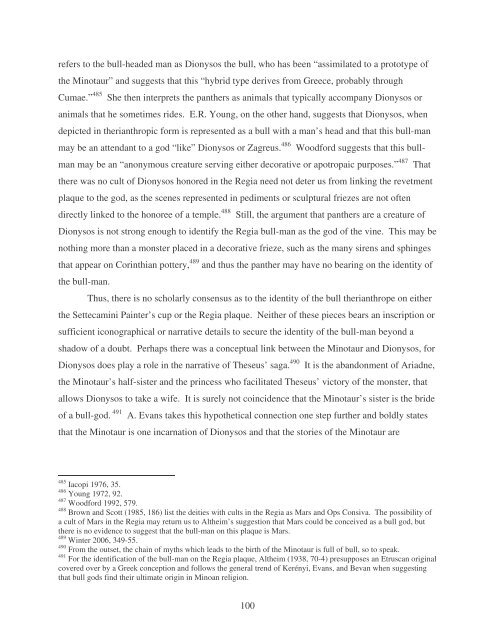Final Draft - Preview Matter - Florida State University
Final Draft - Preview Matter - Florida State University
Final Draft - Preview Matter - Florida State University
Create successful ePaper yourself
Turn your PDF publications into a flip-book with our unique Google optimized e-Paper software.
efers to the bull-headed man as Dionysos the bull, who has been “assimilated to a prototype of<br />
the Minotaur” and suggests that this “hybrid type derives from Greece, probably through<br />
Cumae.” 485 She then interprets the panthers as animals that typically accompany Dionysos or<br />
animals that he sometimes rides. E.R. Young, on the other hand, suggests that Dionysos, when<br />
depicted in therianthropic form is represented as a bull with a man’s head and that this bull-man<br />
may be an attendant to a god “like” Dionysos or Zagreus. 486 Woodford suggests that this bull-<br />
man may be an “anonymous creature serving either decorative or apotropaic purposes.” 487 That<br />
there was no cult of Dionysos honored in the Regia need not deter us from linking the revetment<br />
plaque to the god, as the scenes represented in pediments or sculptural friezes are not often<br />
directly linked to the honoree of a temple. 488 Still, the argument that panthers are a creature of<br />
Dionysos is not strong enough to identify the Regia bull-man as the god of the vine. This may be<br />
nothing more than a monster placed in a decorative frieze, such as the many sirens and sphinges<br />
that appear on Corinthian pottery, 489 and thus the panther may have no bearing on the identity of<br />
the bull-man.<br />
Thus, there is no scholarly consensus as to the identity of the bull therianthrope on either<br />
the Settecamini Painter’s cup or the Regia plaque. Neither of these pieces bears an inscription or<br />
sufficient iconographical or narrative details to secure the identity of the bull-man beyond a<br />
shadow of a doubt. Perhaps there was a conceptual link between the Minotaur and Dionysos, for<br />
Dionysos does play a role in the narrative of Theseus’ saga. 490 It is the abandonment of Ariadne,<br />
the Minotaur’s half-sister and the princess who facilitated Theseus’ victory of the monster, that<br />
allows Dionysos to take a wife. It is surely not coincidence that the Minotaur’s sister is the bride<br />
of a bull-god. 491 A. Evans takes this hypothetical connection one step further and boldly states<br />
that the Minotaur is one incarnation of Dionysos and that the stories of the Minotaur are<br />
485 Iacopi 1976, 35.<br />
486 Young 1972, 92.<br />
487 Woodford 1992, 579.<br />
488 Brown and Scott (1985, 186) list the deities with cults in the Regia as Mars and Ops Consiva. The possibility of<br />
a cult of Mars in the Regia may return us to Altheim’s suggestion that Mars could be conceived as a bull god, but<br />
there is no evidence to suggest that the bull-man on this plaque is Mars.<br />
489 Winter 2006, 349-55.<br />
490 From the outset, the chain of myths which leads to the birth of the Minotaur is full of bull, so to speak.<br />
491 For the identification of the bull-man on the Regia plaque, Altheim (1938, 70-4) presupposes an Etruscan original<br />
covered over by a Greek conception and follows the general trend of Kerényi, Evans, and Bevan when suggesting<br />
that bull gods find their ultimate origin in Minoan religion.<br />
100

















